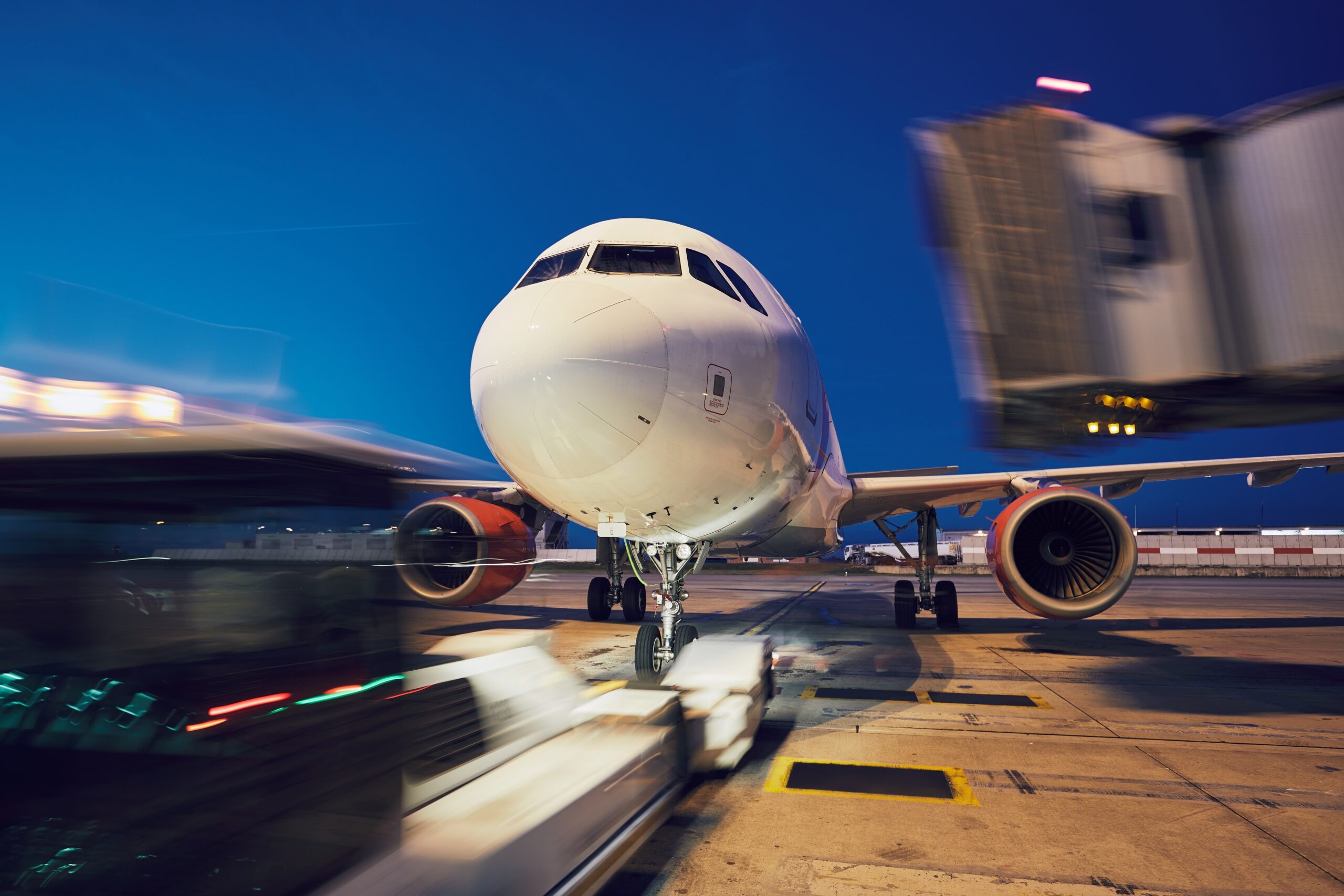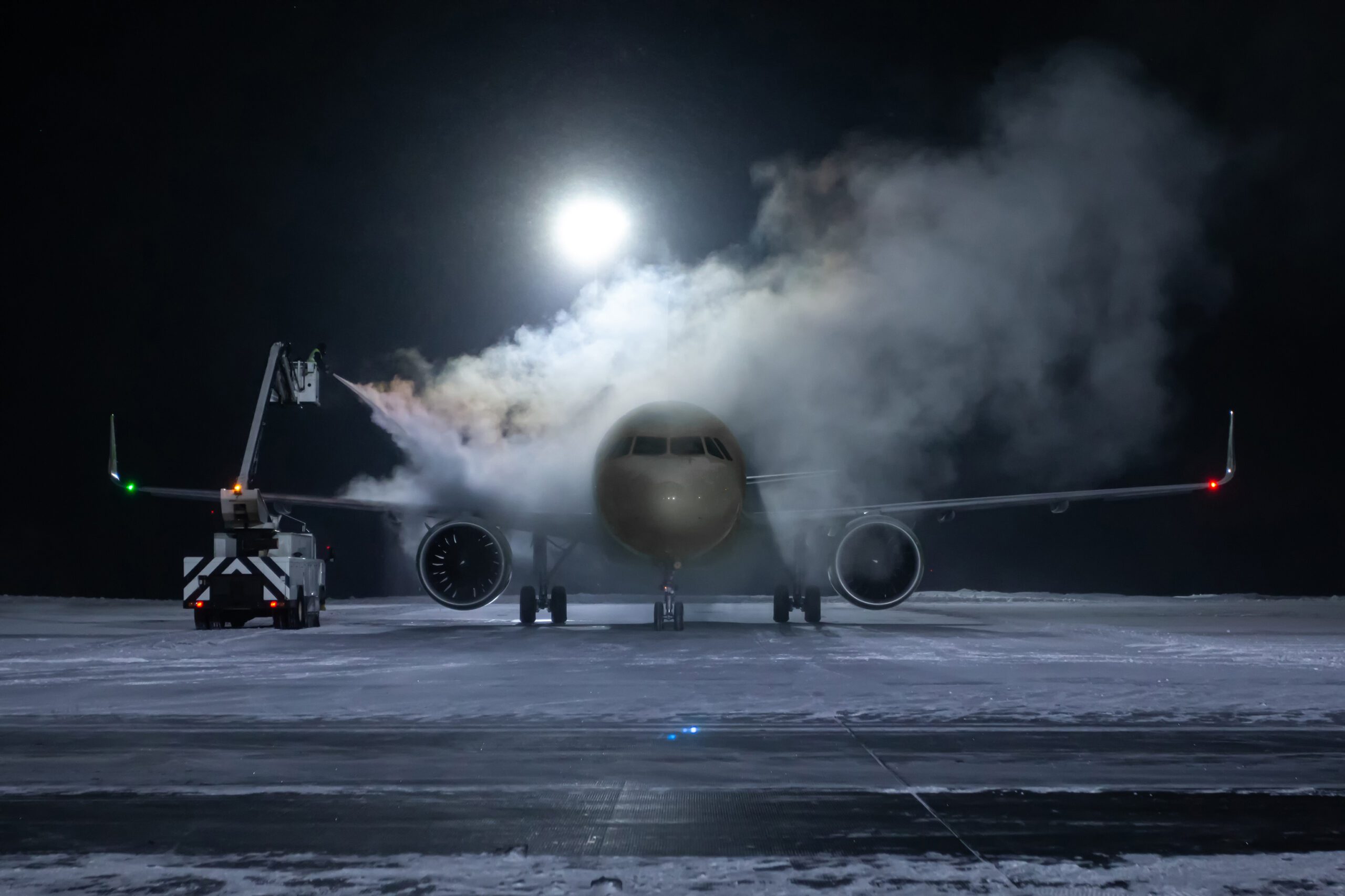Weather intelligence for the future: Crafting a strategic enterprise approach to changing environmental conditions
Continue reading- Predictive analytics help optimize airport operations, reducing delays and improving efficiency.
- Real-time weather monitoring enables faster responses to aviation weather conditions, enhancing safety.
- Airport operations technology minimizes taxi delays, fuel waste, and ground congestion.
- Accurate aircraft weather forecasts improve flight routing, turbulence avoidance, and passenger experience.
Weather is one of the most significant factors affecting airport efficiency, often leading to costly delays, flight cancellations, and logistical bottlenecks. While traditional forecasting methods provide a general outlook, they lack the precision needed for dynamic airport operations. Advanced weather intelligence from The Weather Company is changing that, offering predictive analytics, real-time monitoring, and data-driven decision-making tools that help aviation leaders minimize disruptions.
By integrating cutting-edge airport operations technology, airports can proactively respond to aviation weather conditions, to help improve everything from runway management to gate assignments. With more accurate forecasts, airlines and ground crews can better anticipate adverse weather and airports can function more smoothly, leading to better passenger experiences and operational savings.
The impact of weather on airport operations
Weather is responsible for a significant portion of air travel disruptions. According to industry data, 74% of flight delays exceeding 15 minutes can be directly attributed to weather-related issues.1 Snow, thunderstorms, turbulence, and low visibility can halt or slow down airport activity, creating a ripple effect that affects airlines, ground crews, and passengers.
The consequences of these disruptions are costly. In 2024, travelers lost more than 20 minutes to taxi-out times at some of the nation’s biggest airports, with LaGuardia topping the list at 23 minutes.2 These delays not only inconvenience passengers but also contribute to excessive fuel burn and increased emissions. Inefficient ground operations and flight delays can cost airlines millions annually, making airport operations optimization a key priority.
How predictive analytics optimizes airport efficiency
Our advanced airport operations technology leverages predictive analytics to help airports better prepare for and respond to aviation weather conditions. Unlike traditional weather monitoring systems, predictive analytics can provide highly detailed, location-specific insights that allow airports to make proactive operational decisions.
For example, predictive analytics can help optimize runway usage by forecasting when storms or snow will impact airport operations. Rather than reacting to adverse conditions as they occur, airports can deploy de-icing teams in advance, re-evaluate ATFM slots based on expected delays, and provide alternative landing paths to minimize holding patterns. These proactive measures significantly reduce disruptions, allowing flights to stay on schedule even in challenging weather conditions.
Industry research suggests that with more accurate and timely weather predictions, airports could prevent as many as two-thirds of weather-related delays and cancellations.3 By integrating predictive analytics into their decision-making processes, aviation leaders can transform weather from an operational obstacle into a manageable factor.
Real-time weather monitoring for smarter decision making
In addition to predictive analytics, real-time weather monitoring from The Weather Company plays a crucial role in airport operations efficiency. While long-term forecasts help with planning, live weather data is essential for managing day-to-day airport logistics.
Global Surface Movement within Maverick™ Dispatch provides this critical data. This critical feature provides continuous, high-resolution monitoring of runway conditions, arrival and departure trends, and taxiway congestion. With this data, dispatchers and pilots can better coordinate pushback and taxiing, reducing unnecessary delays and improving fuel efficiency.
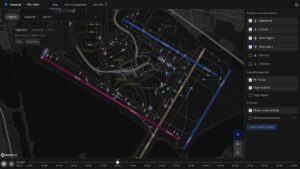
GSM quickly visualizes ramp, taxiway, and runway conditions
For instance, by tracking real-time runway conditions, dispatchers can better determine whether an aircraft will soon be cleared for takeoff. This allows pilots to decide whether to taxi using only one engine, conserving fuel if a longer wait is expected. At high-traffic airports where taxi-out delays can exceed 30 minutes, such optimizations lead to significant cost savings and lower carbon emissions.
Real-time weather monitoring also enables airports to adjust operations as conditions change. If an unexpected thunderstorm develops near a major hub, air traffic controllers can adjust arrival sequences to minimize airborne holding, reducing fuel waste and passenger delays. The ability to adapt quickly to shifting aviation weather conditions is key to maintaining efficient and resilient airport operations.
Airport operations technology that leverages weather intelligence
The latest advancements in airport operations technology rely on weather intelligence to improve efficiency and minimize delays. Maverick Dispatch is a prime example, providing real-time weather insights that enhance flight scheduling, ground movement, and air traffic management.
Maverick Dispatch integrates high-resolution weather data with operational workflows, helping airports anticipate and respond to changing conditions. Key features include:
- Analytics toolkit: AI models like terminal airspace convection risk (TrACR) overlay, airport arrival rate (AAR), and airport departure rate (ADR) bring critical weather intelligence directly into operational workflows.
- IROPs management: Gate-to-gate flight tracking with real-time IROP event updates visualizes weather impacts for proactive flight management during disruptions for faster, efficient responses.
- NOTAM viewer: Supports operational awareness by enabling users to input specific airports or airspaces and quickly retrieve applicable Notices to Airmen (NOTAMs). These alerts can be grouped by type — such as runway closures, airspace restrictions, or navigational aids — and filtered by issuance time or validity period. The result is stronger situational awareness and quicker, more informed decisions in complex environments.
Additionally, automated de-icing systems now use predictive weather insights to determine the optimal time to deploy de-icing crews. This prevents excessive delays while helping promote aircraft safety in winter weather conditions. As taxi-out times and runway congestion continue to challenge major airports, integrating these weather-driven technologies will be essential for improving overall efficiency.
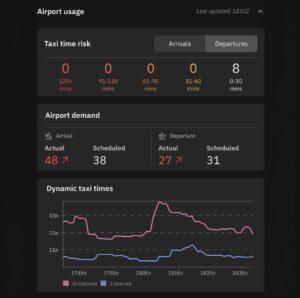
Predictive airport intelligence gives visibility into taxiway impacts
The role of aircraft weather forecasts in passenger safety
Beyond operational efficiency, aircraft weather forecasts play a crucial role in passenger safety and comfort. Unexpected turbulence, wind shear, and convective storms can pose risks to passengers and crew members, making accurate weather forecasting essential for smooth and safe flights. Our aviation solutions platform helps you maintain your commitment to safety through features such as:
- Total Turbulence Alerting: Provides real-time updates on turbulence intensity, allowing pilots to adjust altitude or flight paths before encountering rough air. This proactive approach enhances passenger comfort while significantly reducing the risk of in-flight injuries. Between 2009 and 2023, 79% of serious turbulence-related injuries involved crew members, highlighting the need for better turbulence-avoidance tools.4
- Global High-Resolution Atmospheric Forecasting (GRAF) system: Delivers hyper-localized forecasts with three times the resolution of conventional models. By providing detailed insights into convection, precipitation, and wind patterns, GRAF helps pilots make better-informed routing decisions. This reduces the likelihood of weather-related diversions and delays, contributing to a smoother travel experience for passengers.
- Runway Visual Range (RVR) forecast: Plays a vital role in flight safety by providing visibility data for takeoffs and landings. When combined with predictive analytics and real-time monitoring, these tools allow pilots and air traffic controllers to make informed decisions on instrument landing system minimums, minimizing disruptions and keeping flights operating safely.
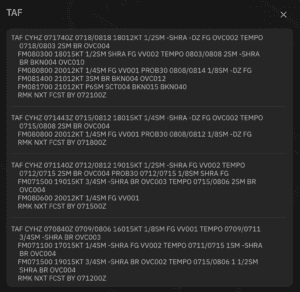
Easily access forecast conditions and quickly see how the forecast has been changing over time
A more efficient future for weather and airports
As the aviation industry continues to evolve, integrating advanced weather intelligence into airport operations will be key to improving efficiency and reducing delays. With the right airport operations technology, airports can anticipate and respond to aviation weather conditions more effectively, optimizing flight schedules, minimizing fuel waste, and enhancing passenger safety.
By leveraging predictive analytics, real-time weather monitoring, and high-resolution aircraft weather forecasts from the world’s most accurate forecaster,5 aviation leaders can transform how weather and airports interact. These innovations will not only lead to smoother operations but also create a more resilient and efficient air travel experience for airlines, crews, and passengers alike.
With the right tools, airports can turn weather challenges into opportunities for smarter, more sustainable aviation.
Let's talk
To learn more about our advanced aviation weather solutions, contact our aviation experts today.
Contact us1 Federal Aviation Administration, FAQ: Weather Delay, 2025
2 Upgraded Points, Upgraded Points Study Reveals Which Airports Waste the Most of Your Time While Traveling, 2024
4 Safety Compass, Flight Attendants Continue to Be Seriously Injured in Turbulence, 2023
5 ForecastWatch, Global and Regional Weather Forecast Accuracy Overview, 2021-2024, commissioned by The Weather Company

